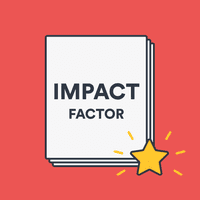How to use the ERIC database: the complete tutorial

What is the ERIC database?
ERIC (Education Resources Information Center) is a database that provides more than 1.6 million texts related to all aspects of education.
➡️ ERIC can be freely accessed at https://eric.ed.gov/
The ERIC research database is sponsored by the Institute of Education Sciences within the United States Department of Education. It is the largest database for education literature and contains resources dating back to 1966.
ERIC database resources
There are a variety of resources available within ERIC, including:
- Journal articles
- Conference proceedings
- Executive summaries of meetings
- Government publications
- Dissertations and theses
- Books and book chapters
- Audiovisual resources
Currently, ERIC includes over 250 journals, selected based on specific criteria. Because it is primarily a resource for education-related texts, an entire journal is only included if more than 80% of its articles focus on education.
If the percentage is lower than 80%, articles are selected on a case-by-case basis. ERIC content is updated monthly, so new resources are added frequently.
How to search ERIC by keyword and subject
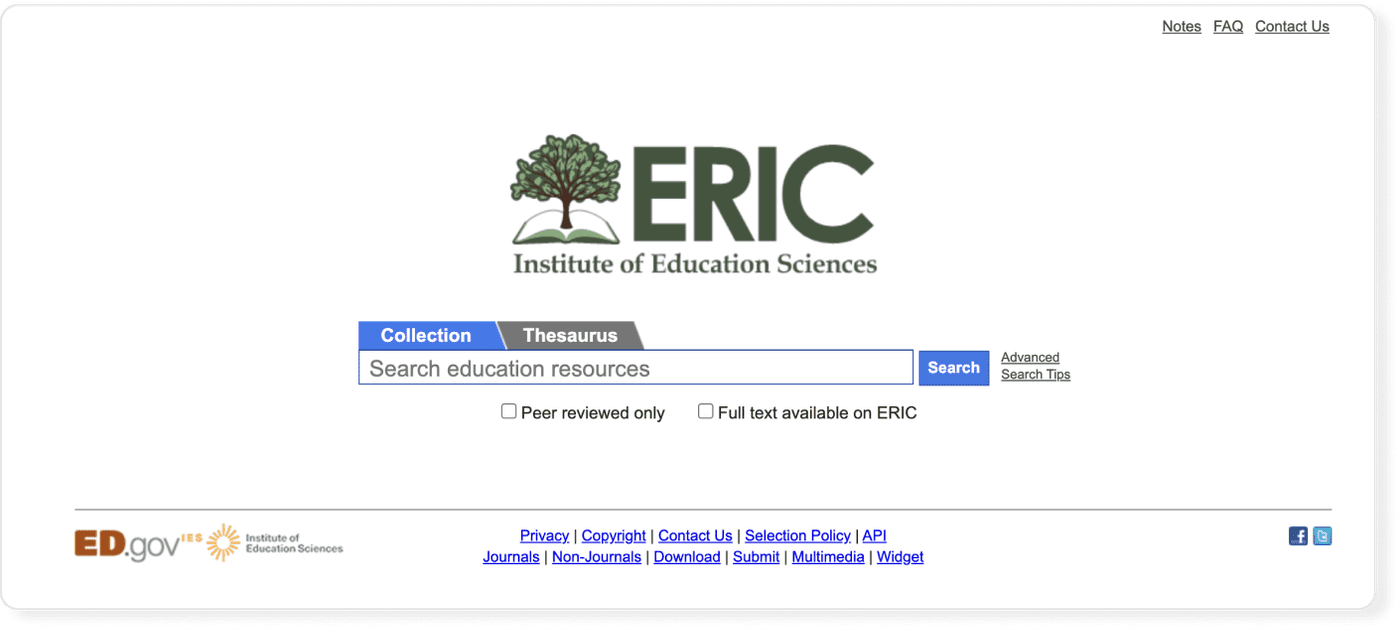
Steps for searching ERIC by keyword or subject
- To begin a basic search in ERIC, choose whether to search via the collection or the thesaurus. You will have to search differently based on which method you choose.
- To search via the collection, you will need to enter keywords, for example: “higher education,” “mobile learning,” or “augmented reality.” ERIC will then search all articles that have these keywords indexed in the bibliographic record.
➡️ The ERIC Youtube channel also has some great videos to get you started.
ERIC search results example
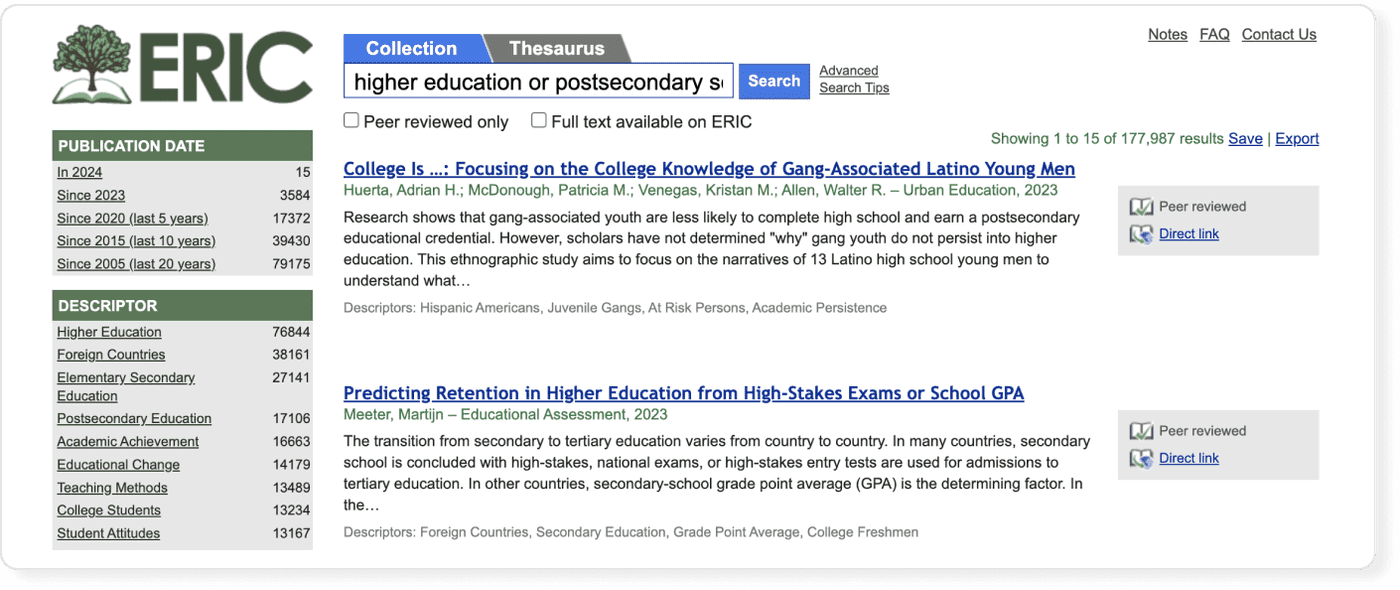
The number of results in the above example is 177,987. This is far too many to work through, so you could use the following filters to narrow your results:
- Peer reviewed only: limits the search to texts that have undergone the peer review process.
- Full text available on ERIC: only shows results available in full text within ERIC.
Applying both of these limiters reduces the number of results significantly.
➡️ Learn more about peer review in our guide: What are peer reviewed journals
Pro tip: Consider using a reference manager like Paperpile to save, organize, and cite your references. Paperpile integrates with ERIC and many popular databases, so you can save references and PDFs directly to your library using the Paperpile buttons:
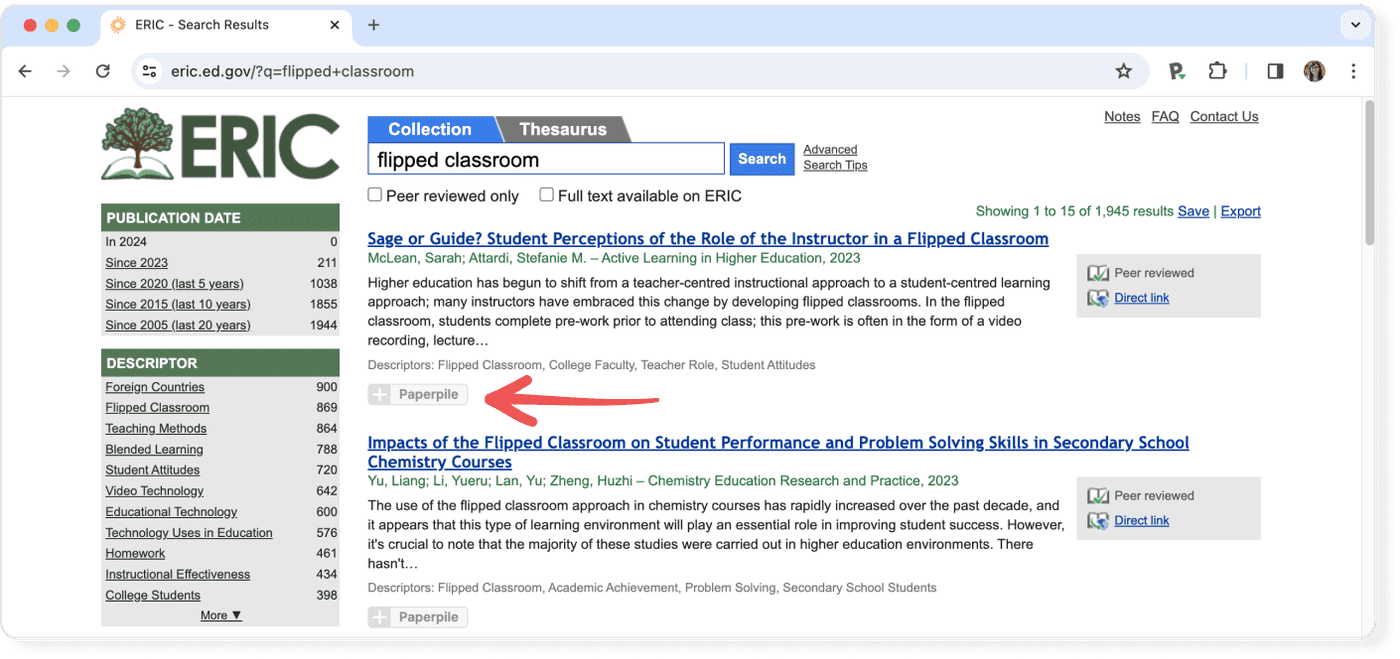
ERIC filters
Use the following filters to refine your search results:
| Filter | Field name | Description |
|---|---|---|
Publication date | pubyear | The year the text was published. |
Descriptor | descriptor | These are subject terms which show more relevant search results than when searching with keywords. |
Source | source | Name of the journal or publisher. |
Author | author | The author of the text, or contributors to conference proceedings. |
Education level | educationlevel | ERIC allows for limiting search by education level such as K-12 or higher education to more granular divisions. |
Audience | audience | The author may not always choose to tag the audience, but it is an option which allows them to select the audience who would be most interested in that particular resource. |
Location | location | States or countries. |
Related policy | law | This field generates resources that talk about a particular policy. In the case of cyber charter schools, one of the policy tags is No Child Left Behind |
Related assessment or survey | assessment | Further texts relating to the topic. |
Conducting a thesaurus search in ERIC
The thesaurus search is a search for subject descriptors: an organized group of similar topics in a research area. When entering a search in the thesaurus, you will be presented with a list of descriptors which match your search term.
For example, the image below shows the suggested descriptors for a search for “migration.”

Clicking on any of these links will bring you to a descriptor page. You can use the descriptor by clicking the “Search collection using this descriptor” link, as shown in the screenshot below. The page also includes many related descriptors to help narrow or widen your search.
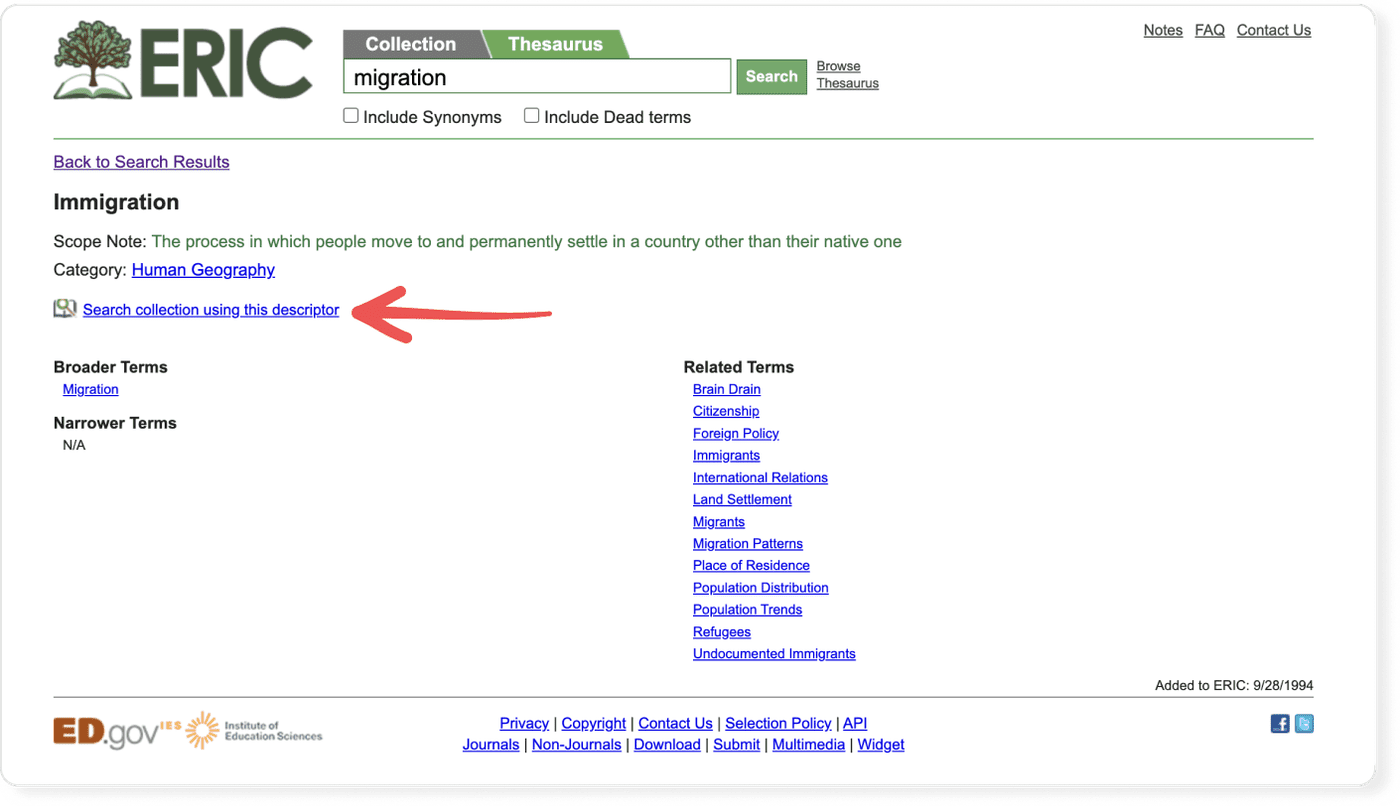
Once a descriptor has been chosen, the presented results can be further narrowed with additional filters, just like a keyword search. However, if you apply the full text available on ERIC or the peer reviewed only filter, then the search will revert to a keyword search.
ERIC advanced search features
Sometimes it is necessary to run an advanced search. This means that you select different fields before you begin the search.
The most straightforward advanced search feature is to use Boolean operators and quotes. Boolean operators include the words:
- AND
- OR
- NOT
Using AND combines terms, using OR allows for either term to appear, and using NOT searches one term but not another.
➡️ Read more about how to efficiently search online databases for academic research.
A common reason to use NOT is when searching for Greek life in higher education. Several of the search results will be related to drinking or enforced restrictions on parties. However, Greek life also engages in philanthropy and service learning. By entering “Greek life” NOT “drinking,” the results will eliminate any articles that refer to drinking.
You can also use field names to narrow your search. For example, papers on migration, by the author Roberts, can be found using the search term “migration, author:roberts.” The available field names are presented in the filters table, above. In addition, you can also use the “title” and “abstract” field names.
One of ERIC’s unique advanced search features is the ability to search using the ERIC accession number, which is available only for ERIC documents. Results are typically displayed with the most recent publications first, but this feature requires you to have the ERIC accession number in advance.
Retrieving the full text article in ERIC
Once you’ve filtered down your search results, you’ll want to access the full text. Click the "Direct link" option in the gray box to the right of the search result to go to the publisher’s page, where you can access the full text of the article.
Keep in mind that if your institution or workplace doesn’t provide access, many of these direct links may be inaccessible. However, if the article is published under an approved open access model, you may still be able to view it.

ERIC is a very specialized database for researchers in education and related areas. As such, the results are often of high quality. It's main search functions are much like any other academic database or academic search engine, but they also includes a thesaurus search which provides comprehensive results for research in selected sub-areas and topics within education research.
➡️ Working on a literature review? Visit our guide on how to write a literature review.
Alternative ERIC access routes
ERIC can also be accessed via several research database providers. These offer additional access to full text articles, but you need an institutional subscription to access them.
Frequently Asked Questions about using ERIC
🐘 What does ERIC stand for?
ERIC stands for Education Resources Information Center and is a database that provides more than 1.6 million texts related to all aspects of education.
🐐 How do I access ERIC?
ERIC can be freely accessed at https://eric.ed.gov/
🐪 Is ERIC an academic database?
Yes, ERIC provides access to bibliographic records of journal and non-journal literature from 1966 to the present. The database is considered an academic source.
🦙 Is ERIC peer-reviewed?
Yes, most of the education journals that ERIC indexes are peer-reviewed.
🦛 How much does the ERIC database cost?
The ERIC website is freely accessible to the public, courtesy of the Institute of Education Sciences at the U.S. Department of Education. No membership or subscription is needed.
